key TOYOTA C-HR 2021 Owners Manual (in English)
[x] Cancel search | Manufacturer: TOYOTA, Model Year: 2021, Model line: C-HR, Model: TOYOTA C-HR 2021Pages: 548, PDF Size: 12.51 MB
Page 424 of 548
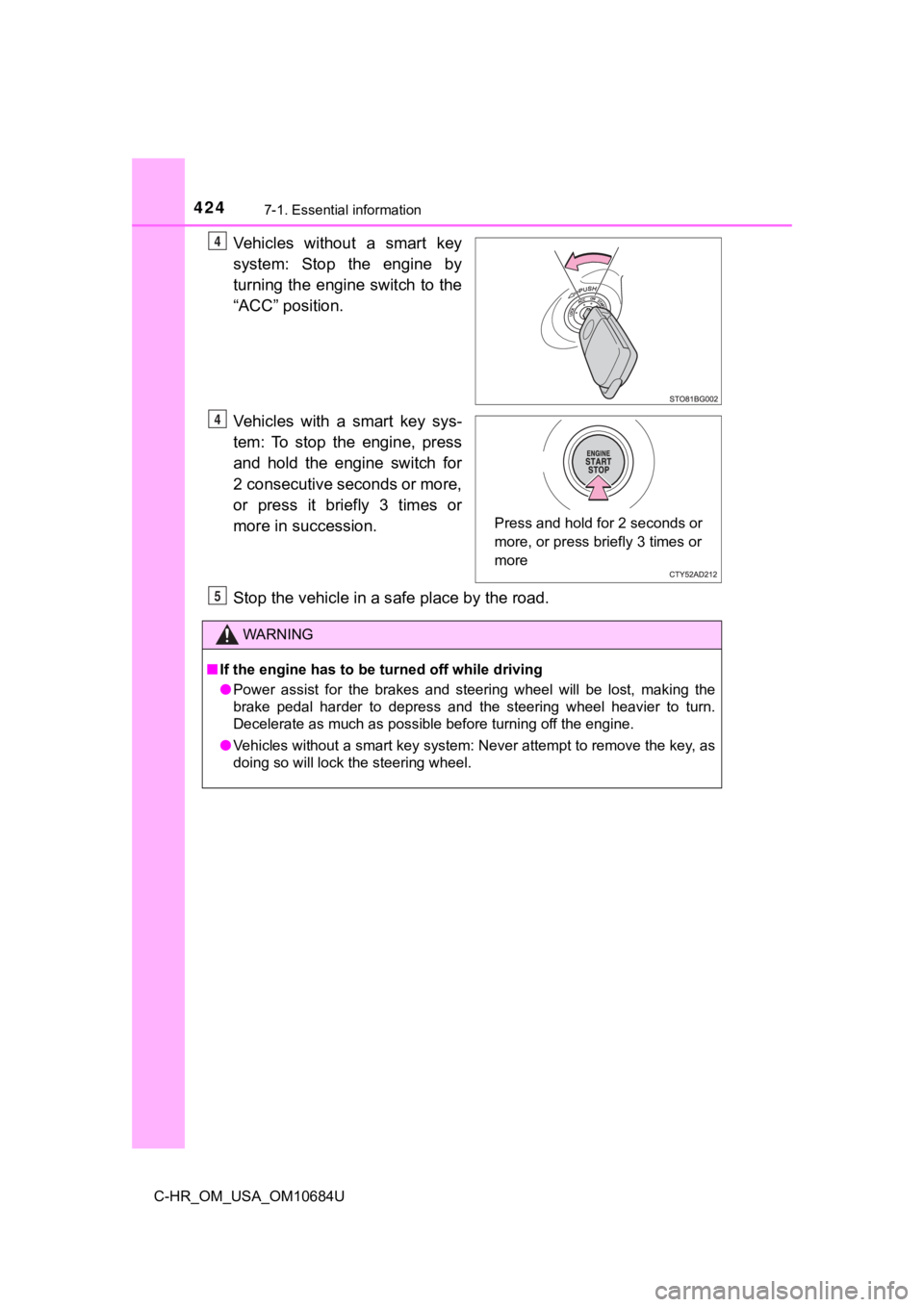
4247-1. Essential information
C-HR_OM_USA_OM10684U
Vehicles without a smart key
system: Stop the engine by
turning the engine switch to the
“ACC” position.
Vehicles with a smart key sys-
tem: To stop the engine, press
and hold the engine switch for
2 consecutive seconds or more,
or press it briefly 3 times or
more in succession.
Stop the vehicle in a s afe place by the road.4
Press and hold for 2 seconds or
more, or press briefly 3 times or
more
Q
WARNING
■If the engine has to be tu rned off while driving
● Power assist for the brakes and steering wheel will be lost, ma king the
brake pedal harder to depress and the steering wheel heavier to turn.
Decelerate as much as possible before turning off the engine.
● Vehicles without a smart key system: Never attempt to remove the key, as
doing so will lock the steering wheel.
5
Page 427 of 548
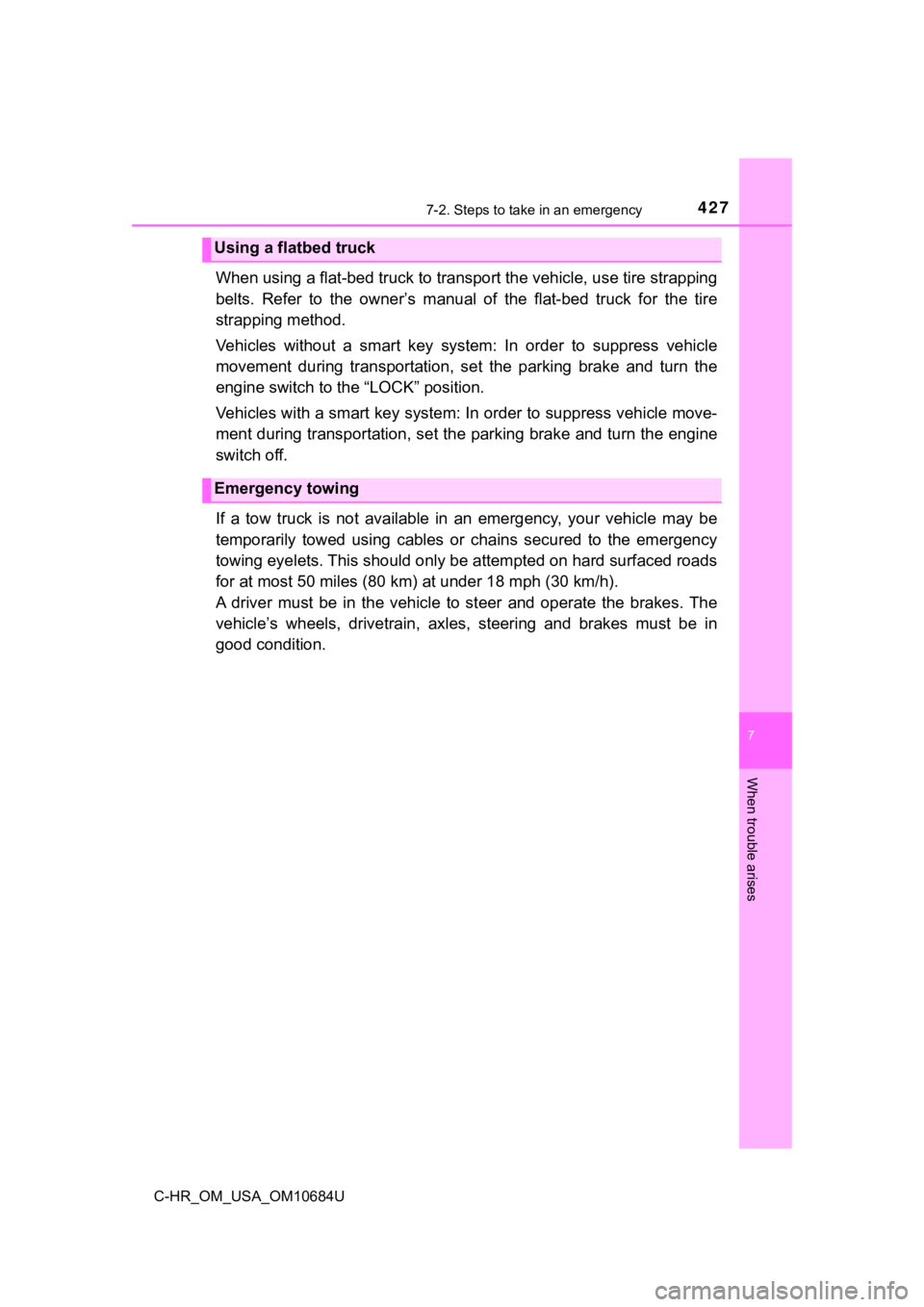
4277-2. Steps to take in an emergency
7
When trouble arises
C-HR_OM_USA_OM10684U
When using a flat-bed truck to transport the vehicle, use tire strapping
belts. Refer to the owner’s manual of the flat-bed truck for th e tire
strapping method.
Vehicles without a smart key system: In order to suppress vehic le
movement during transportation, set the parking brake and turn the
engine switch to the “LOCK” position.
Vehicles with a smart key system: In order to suppress vehicle move-
ment during transportation, set the parking brake and turn the engine
switch off.
If a tow truck is not available in an emergency, your vehicle m ay be
temporarily towed using cables or chains secured to the emergen cy
towing eyelets. This should only be attempted on hard surfaced roads
for at most 50 miles (80 km) at under 18 mph (30 km/h).
A driver must be in the vehicle to steer and operate the brakes . The
vehicle’s wheels, drivetrain, axles, steering and brakes must b e in
good condition.
Using a flatbed truck
Emergency towing
Page 429 of 548

4297-2. Steps to take in an emergency
7
When trouble arises
C-HR_OM_USA_OM10684U
Securely attach cables or chains to the towing eyelet.
Take care not to damage the vehicle body.
Vehicles without a smart key system: Enter the vehicle being to wed
and start the engine.
If the engine does not start, turn the engine switch to the “ON ” position.
Vehicles with a smart key system: Enter the vehicle being towed
and start the engine.
If the engine does not start, turn the engine switch to IGNITION ON mode.
Shift the shift lever to N and release the parking brake.
Turn automatic mode off. ( P. 196)
When the shift lever cannot be shifted: P. 1 9 3
■While towing
If the engine is not running, the power assist for the brakes a nd steering will
not function, making steering and braking more difficult.
■ Wheel nut wrench
Wheel nut wrench is installed in the luggage compartment. ( P. 450)
5
6
7
Page 430 of 548
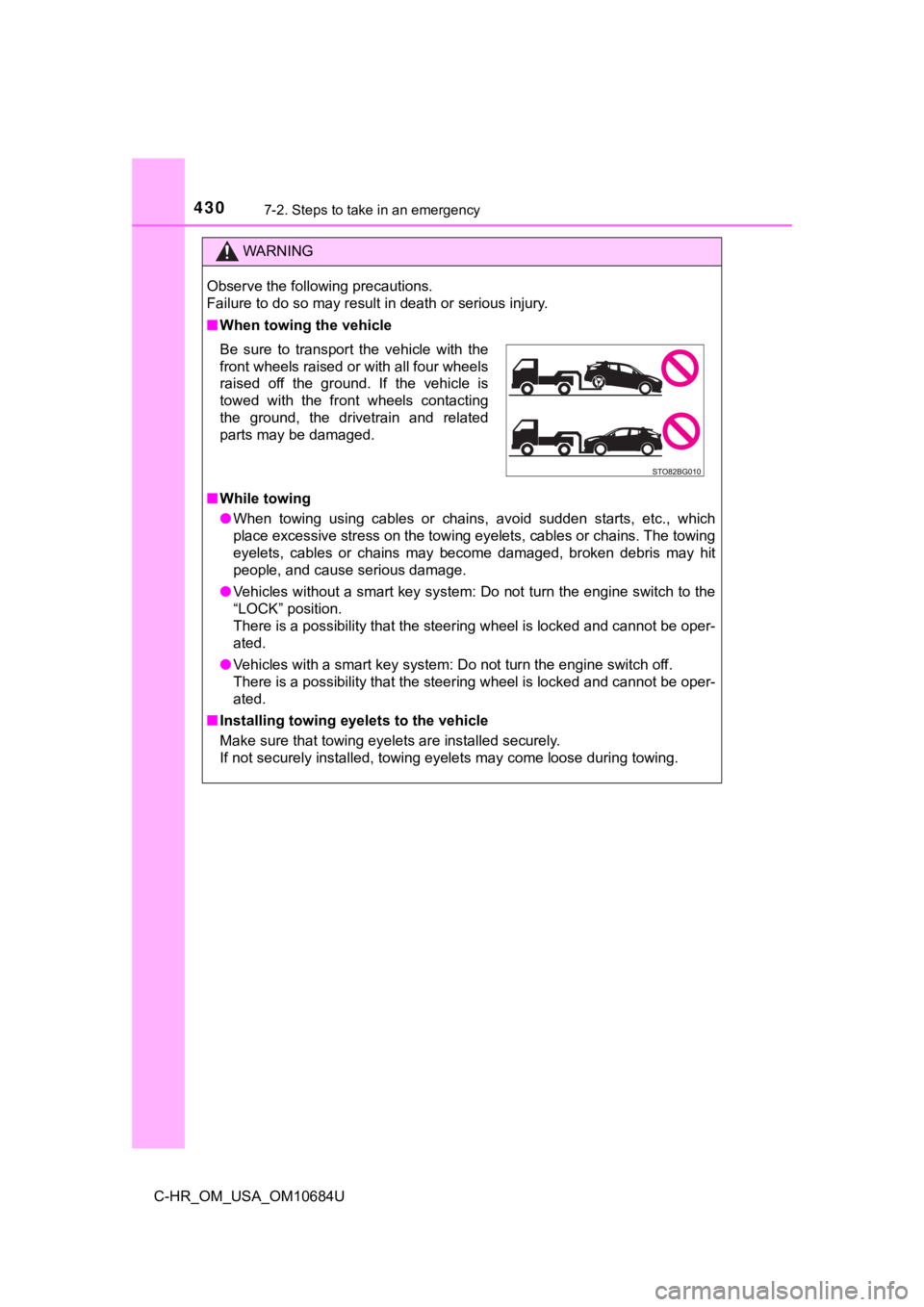
4307-2. Steps to take in an emergency
C-HR_OM_USA_OM10684U
WARNING
Observe the following precautions.
Failure to do so may result in death or serious injury.
■When towing the vehicle
■ While towing
● When towing using cables or chains, avoid sudden starts, etc., which
place excessive stress on the towing eyelets, cables or chains. The towing
eyelets, cables or chains may become damaged, broken debris may hit
people, and cause serious damage.
● Vehicles without a smart key system: Do not turn the engine switch to the
“LOCK” position.
There is a possibility that the steering wheel is locked and ca nnot be oper-
ated.
● Vehicles with a smart key system: Do not turn the engine switch off.
There is a possibility that the steering wheel is locked and ca nnot be oper-
ated.
■ Installing towing eyelets to the vehicle
Make sure that towing eyelets are installed securely.
If not securely installed, towing eyelets may come loose during towing.
Be sure to transport the vehicle with the
front wheels raised or with all four wheels
raised off the ground. If the vehicle is
towed with the front wheels contacting
the ground, the drivetrain and related
parts may be damaged.
Page 431 of 548
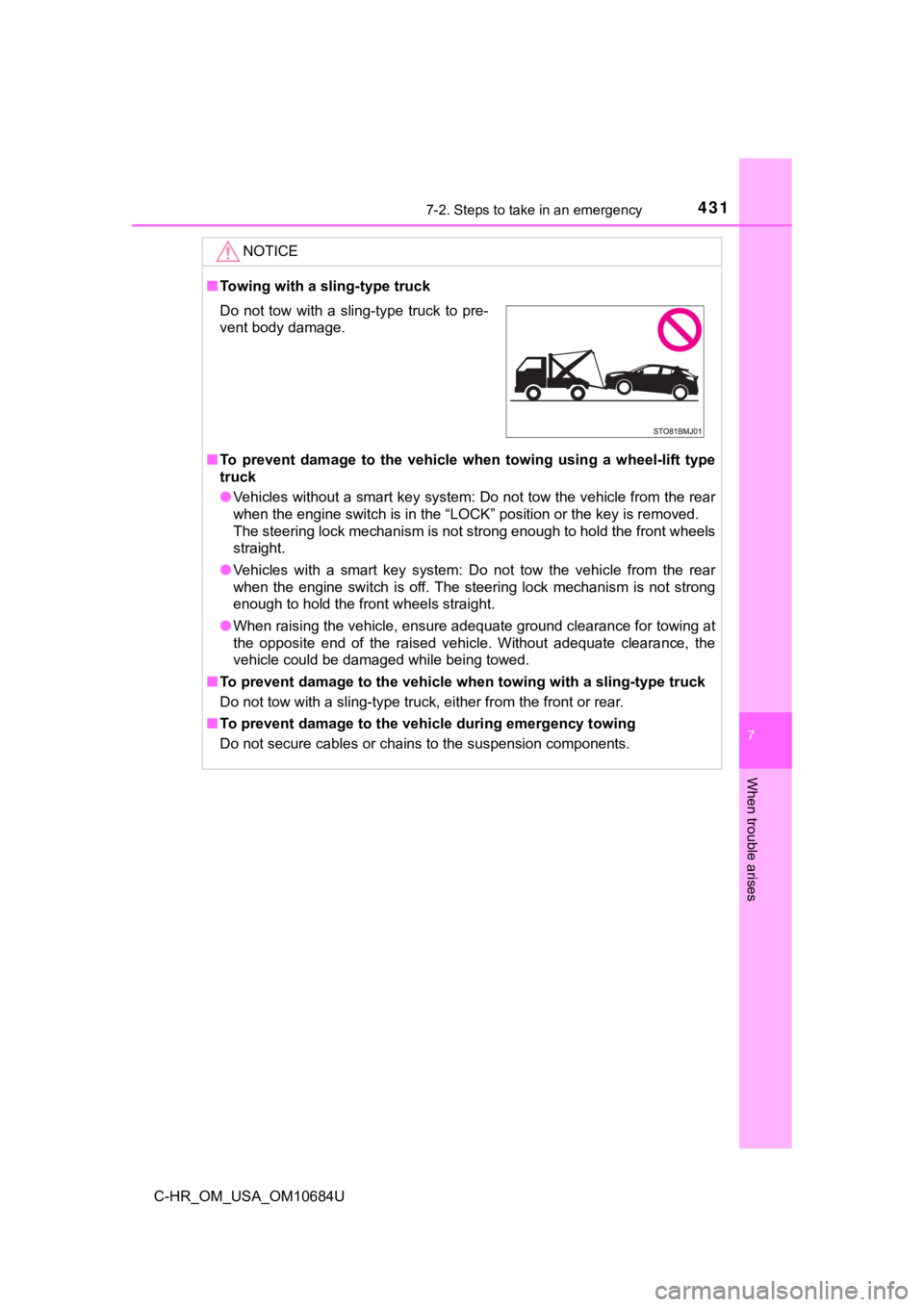
4317-2. Steps to take in an emergency
7
When trouble arises
C-HR_OM_USA_OM10684U
NOTICE
■Towing with a sling-type truck
■ To prevent damage to the vehicle when towing using a wheel-lift type
truck
● Vehicles without a smart key system: Do not tow the vehicle fro m the rear
when the engine switch is in the “LOCK” position or the key is removed.
The steering lock mechanism is not strong enough to hold the front wheels
straight.
● Vehicles with a smart key system: Do not tow the vehicle from the rear
when the engine switch is off. The steering lock mechanism is n ot strong
enough to hold the front wheels straight.
● When raising the vehicle, ensure adequate ground clearance for towing at
the opposite end of the raised vehicle. Without adequate clearance, the
vehicle could be damaged while being towed.
■ To prevent damage to the vehicle when towing with a sling-type truck
Do not tow with a sling-type truck, either from the front or re ar.
■ To prevent damage to the vehic le during emergency towing
Do not secure cables or chains to the suspension components.
Do not tow with a sling-type truck to pre-
vent body damage.
Page 433 of 548
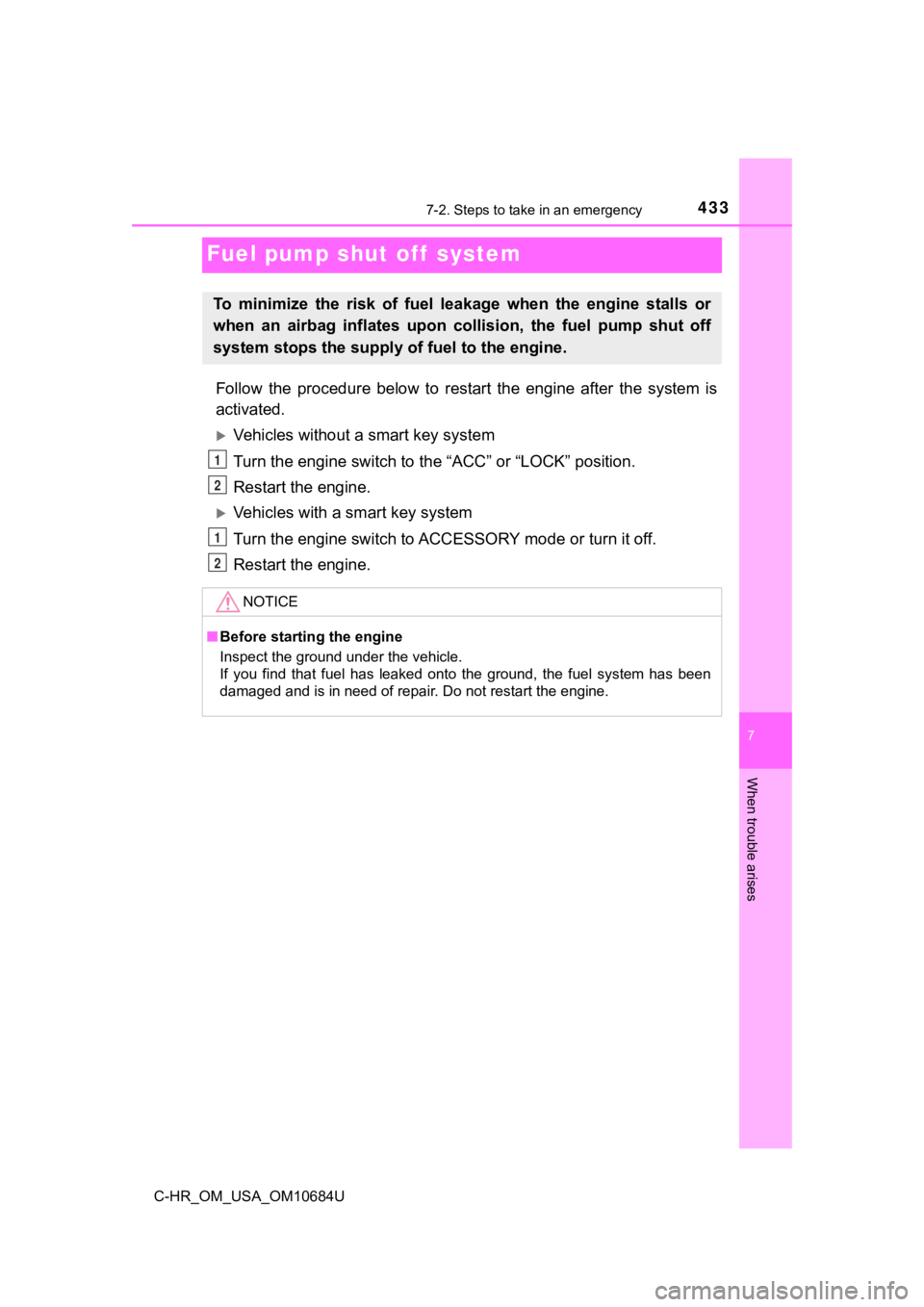
4337-2. Steps to take in an emergency
C-HR_OM_USA_OM10684U
7
When trouble arises
Fuel pump shut off system
Follow the procedure below to restart the engine after the system is
activated.
Vehicles without a smart key system
Turn the engine switch to the “ACC” or “LOCK” position.
Restart the engine.
Vehicles with a smart key system
Turn the engine switch to ACCESSORY mode or turn it off.
Restart the engine.
To minimize the risk of fuel leakage when the engine stalls or
when an airbag inflates upon collision, the fuel pump shut off
system stops the supply of fuel to the engine.
NOTICE
■ Before starting the engine
Inspect the ground under the vehicle.
If you find that fuel has leaked onto the ground, the fuel system has been
damaged and is in need of repair. Do not restart the engine.
1
2
1
2
Page 438 of 548
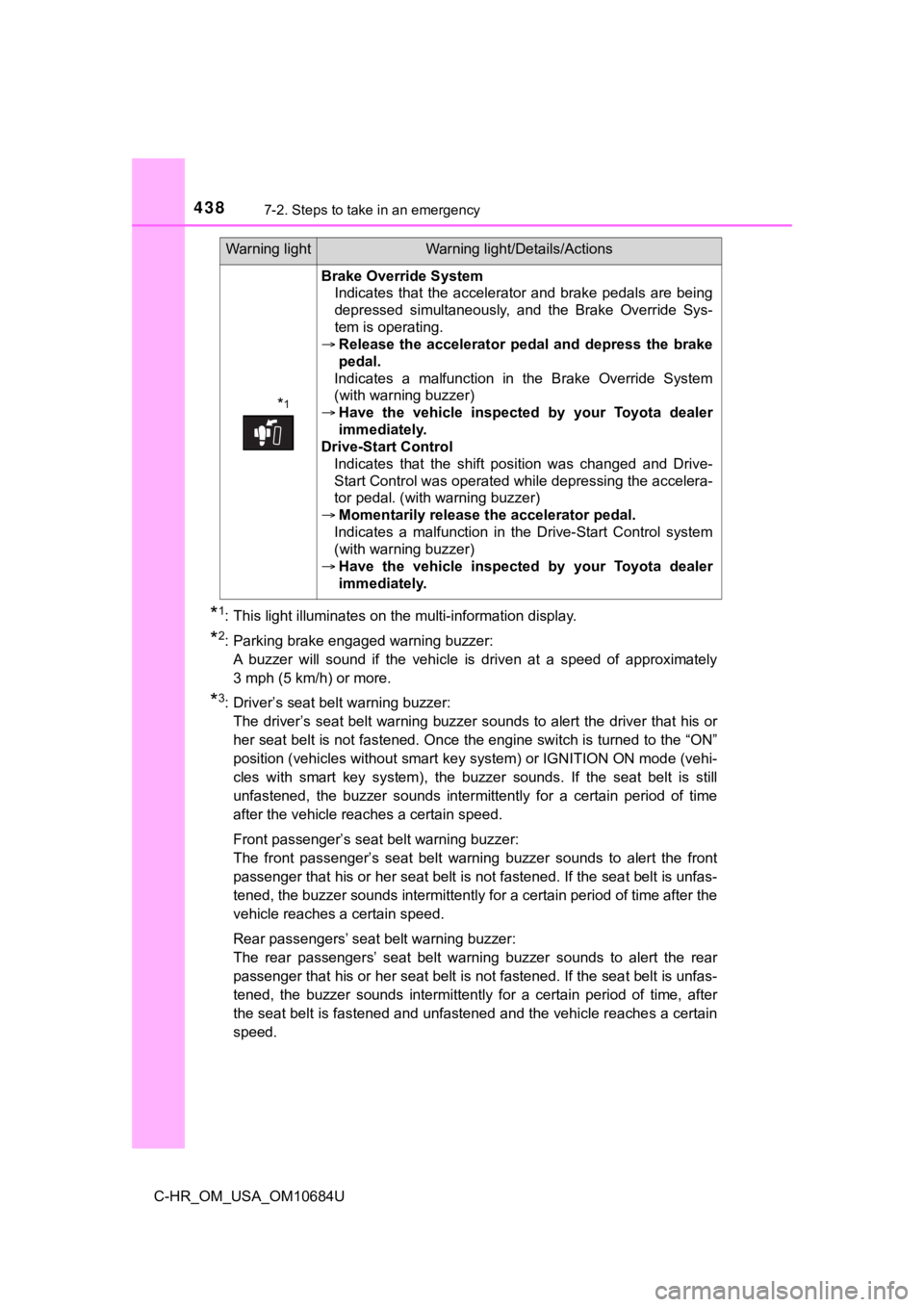
4387-2. Steps to take in an emergency
C-HR_OM_USA_OM10684U
*1: This light illuminates on the multi-information display.
*2: Parking brake engaged warning buzzer:A buzzer will sound if the vehicle is driven at a speed of appr oximately
3 mph (5 km/h) or more.
*3: Driver’s seat belt warning buzzer: The driver’s seat belt warning buzzer sounds to alert the drive r that his or
her seat belt is not fastened. Once the engine switch is turned to the “ON”
position (vehicles without smart key system) or IGNITION ON mod e (vehi-
cles with smart key system), the buzzer sounds. If the seat bel t is still
unfastened, the buzzer sounds intermittently for a certain peri od of time
after the vehicle reaches a certain speed.
Front passenger’s seat belt warning buzzer:
The front passenger’s seat belt warning buzzer sounds to alert the front
passenger that his or her seat belt is not fastened. If the sea t belt is unfas-
tened, the buzzer sounds intermittently for a certain period of time after the
vehicle reaches a certain speed.
Rear passengers’ seat belt warning buzzer:
The rear passengers’ seat belt warning buzzer sounds to alert t he rear
passenger that his or her seat belt is not fastened. If the sea t belt is unfas-
tened, the buzzer sounds intermittently for a certain period of time, after
the seat belt is fastened and unfastened and the vehicle reache s a certain
speed.
*1
Brake Override System Indicates that the accelerator and brake pedals are being
depressed simultaneously, and the Brake Override Sys-
tem is operating.
Release the accelerator pedal and depress the brake
pedal.
Indicates a malfunction in the Brake Override System
(with warning buzzer)
Have the vehicle inspected by your Toyota dealer
immediately.
Drive-Start Control Indicates that the shift position was changed and Drive-
Start Control was operated while depressing the accelera-
tor pedal. (with warning buzzer)
Momentarily release the accelerator pedal.
Indicates a malfunction in the Drive-Start Control system
(with warning buzzer)
Have the vehicle inspected by your Toyota dealer
immediately.
Warning lightWarning light/Details/Actions
Page 440 of 548

4407-2. Steps to take in an emergency
C-HR_OM_USA_OM10684U■
When the tire pressure warning light comes on
Inspect the appearance of the ti
re to check that the tire is not punctured.
If the tire is punctured: P. 449
If the tire is not punctured:
Carry out the following procedure after the tire temperature has lowered
sufficiently.
●Check the tire inflation pressure and adjust to the appropriate level.
●If the warning light does not go out even after several minutes , check
that the tire inflation pressure is at the specified level and carry out ini-
tialization. ( P. 3 7 8 )
The warning light may come on again if the above operations are con-
ducted without first allowing t he tire temperature to lower suf ficiently.
■The tire pressure warning light may come on due to natural caus es
The tire pressure warning light may come on due to natural caus es such
as natural air leaks and tire inflation pressure changes caused by tem-
perature. In this case, adjusting the tire inflation pressure w ill turn off the
warning light (afte r a few minutes).
■When a tire is replace d with a spare tire
The compact spare tire is not equipped with a tire pressure war ning valve
and transmitter. If a tire goes flat, the tire pressure warning light will not
turn off even though the flat tire has been replaced with the s pare tire.
Replace the spare tire with the repaired tire and adjust the ti re inflation
pressure. The tire pressure war ning light will go off after a few minutes.
■Conditions that the tire pressure warning system may not functi on
properly
P. 3 8 1
■If the tire pressure warning light frequently comes on after bl inking
for 1 minute
If the tire pressure warning light frequently comes on after bl inking for
1 minute when the engine switch is turned to the “ON” position (vehicles
without smart key system) or IGNITION ON mode (vehicles with sm art
key system), have it checked by your Toyota dealer.
■Warning buzzer
In some cases, the buzzer may not be heard because of noisy pla ce or an
audio sound.
Page 447 of 548

4477-2. Steps to take in an emergency
7
When trouble arises
C-HR_OM_USA_OM10684U■
If a message that indicates the need for referring to Owner’s M anual is
displayed
● If “Engine Coolant Temperature High.”is shown, follow the instructions
(P. 470).
● If the following messages are shown, there may be a malfunction . Immedi-
ately stop the vehicle in a safe place and contact your Toyota dealer. Con-
tinuing to drive the vehicle may be dangerous.
• “Braking Power Low.”
• “Charging System Malfunction.”
• “Engine Oil Pressure Low.”
● If the following messages are shown, there may be a malfunction . Immedi-
ately have the vehicle inspected by your Toyota dealer.
• “Smart Key System Malfunction.”
■ If “Engine Oil Level Low. Add or Replace Oil.” is displayed
The engine oil level is low. Check the level of the engine oil, and add if neces-
sary.
This message may appear if the vehicle is stopped on a slope. M ove the
vehicle to a level surface and check to see if the message disa ppears.
■ If “Engine Stopped. Steerin g Power Low.” is displayed
This message is displayed if the engine is stopped while drivin g.
When steering wheel operations are heavier than usual, grip the steering
wheel firmly and operate it using more force than usual.
■ If “Maintenance Required Soon.” is shown (U.S.A. only)
Indicates that all maintenance according to the driven distance on the mainte-
nance schedule
* should be performed soon.
Comes on approximately 4500 miles (7200 km) after the message has been
reset.
If necessary, perform maintenance. Please reset the message aft er the main-
tenance is performed. ( P. 348)
*: Refer to the separate “Scheduled Maintenance Guide” or “Owner ’s Manual
Supplement” for the maintenance interval applicable to your vehicle.
■ If “Maintenance Required. Visit Your Dealer.” is shown (U.S.A. only)
Indicates that all maintenance is required to correspond to the driven distance
on the maintenance schedule
*.
Comes on approximately 5000 miles (8000 km) after the message has been
reset. (The indicator will not work properly unless the message has been
reset.)
Perform the necessary maintenance. Please reset the message aft er the
maintenance is performed. ( P. 348)
*: Refer to the separate “Scheduled Maintenance Guide” or “Owner ’s Manual
Supplement” for the maintenance interval applicable to your vehicle.
Page 448 of 548

4487-2. Steps to take in an emergency
C-HR_OM_USA_OM10684U■
If “A New Key has been Registere d. Contact Your Dealer for Details.” is
shown (vehicles with a smart key system)
This message will be displayed each time the driver’s door is opened when
the doors are unlocked from the outside for approximately one w eek after a
new electronic key has been registered.
If this message is displayed but you have not had a new electro nic key regis-
tered, ask your Toyota dealer to check if an unknown electronic key (other
than those in your possession) has been registered.
■ If a message that indicates the malfunction of front camera is displayed
The following systems may be suspended until the problem shown in the
message is resolved. ( P. 229, 434)
● PCS (Pre-Collision System)
● LTA (Lane Tracing Assist)
● Dynamic radar cruise control with full-speed range
● RSA (Road Sign Assist) (if equipped)
● Automatic High Beam
■
If a message that indicates the ma lfunction of radar sensor is displayed
The following systems may be suspended until the problem shown in the
message is resolved. ( P. 229, 434)
● PCS (Pre-Collision System)
● LTA (Lane Tracing Assist)
● Dynamic radar cruise control with full-speed range
■ If “Radar Cruise Control Unavailable See Owner’s Manual” is sho wn
The dynamic radar cruise control with full-speed range system is suspended
temporarily or until the problem shown in the message is resolv ed. (causes
and coping methods: P. 229)
■ If “Radar Cruise Control unavailable.” is shown
The dynamic radar cruise control with full-speed range system c annot be
used temporarily. Use the system when it becomes available agai n.
■ Warning buzzer
P. 440